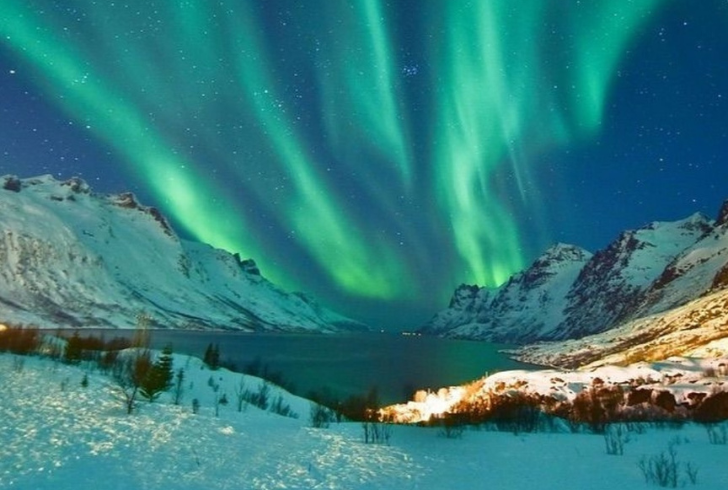
FUNFACTSFORDAYS.COM
Viewing the Aurora Borealis Like Never Before – Insights From Space
The aurora borealis, one of nature’s most spectacular light shows, has captivated people for centuries. Known for its mesmerizing dance of colors in the sky, this phenomenon, often referred to as the northern lights, takes on an ethereal quality as vibrant hues of green, pink, and purple swirl in the polar skies.
While the phenomenon is most commonly observed in high-latitude regions like Alaska, Norway, and Canada, the recent ability to capture these lights from space has offered an entirely new perspective, heightening the mystery and beauty of this natural wonder.
What Is the Aurora Borealis?
The aurora borealis occurs when charged particles from the sun collide with Earth’s atmosphere. These solar winds travel from the sun, and when they meet our planet’s magnetic field, they create bursts of energy that result in the colorful lights we see in the sky. The interaction of these particles with gases in the atmosphere creates various colors. Oxygen, for example, produces green lights, while nitrogen can give off purples and blues. The result is a stunning spectacle that has intrigued scientists and skywatchers alike.
The Science Behind the Northern Lights
Instagram | goinmyway_travels | The aurora borealis results from solar wind interacting with Earth’s atmosphere.
At the heart of the aurora borealis is a fascinating scientific process. The solar wind—the stream of charged particles ejected from the sun—travels across space until it reaches Earth’s magnetosphere. The particles follow the magnetic field lines, converging toward the poles, where the atmosphere is thinner and the magnetic forces stronger. As these particles interact with atmospheric gases, energy is released in the form of light, which is visible to the human eye.
This interaction is dynamic, with the shape, size, and color of the auroras changing based on solar activity. The more intense the solar wind, the more dramatic the display of colors becomes.
The Unique Perspective From Space
Recently, astronaut and astrophotographer Don Pettit shared a breathtaking video captured from the International Space Station (ISS). The footage, taken while the ISS orbited Earth at approximately 250 miles above the surface, provides an extraordinary view of the aurora borealis. From this vantage point, the undulating, radiant bands of color stretch across the planet’s atmosphere, offering a scale and beauty that is not visible from the ground.
Unlike the traditional experience of watching the northern lights from below, space footage presents the aurora as a swirling, glowing phenomenon that envelops the planet. This perspective allows viewers to appreciate the vastness of the event, as the aurora covers large stretches of the atmosphere, creating a visual spectacle that can’t be matched by any ground-level view.
The Pros and Cons of Observing Auroras From Space
Advantages:
1. A Global View – The ISS offers an unobstructed and expansive view of the auroras, which can be seen as they unfold across the Earth’s atmosphere.
2. Unmatched Visuals – The scale and patterns of the auroras are much more pronounced from space, making the viewing experience far more impactful.
3. Scientific Benefits – Viewing auroras from space helps scientists gain insights into solar activity and its interaction with Earth’s atmosphere and magnetic field.
Challenges:
1. Limited Access – Only astronauts aboard the ISS can capture this footage, making this perspective inaccessible to the general public.
2. Timing and Conditions – The auroras are only visible during certain conditions—such as high solar activity or specific orbital paths—which can limit the frequency of sightings.
Space Photography and Its Growing Popularity
Instagram | auroraborealisobservatory | The aurora, especially seen from space, highlights Earth’s delicate beauty.
As technology advances, space photography is becoming more popular, allowing us to appreciate the beauty and complexity of our planet and its interactions with space. Equipped with high-definition cameras, astronauts are capturing stunning images and videos that show Earth’s dynamic beauty from above. These images often garner public interest, drawing attention to the science behind the phenomena and the importance of space exploration.
There is also growing interest in space photography because it can connect people with Earth’s natural wonders. Companies that develop imaging technology for space missions have seen a surge in demand, recognizing the value of showcasing our planet from such a unique perspective.
The Impact on Environmental Awareness
Viewing the aurora borealis, especially in its rare space-based form, serves as a reminder of the fragile beauty of our planet. As people become more fascinated by such natural wonders, there is an increasing awareness of the need to protect the environment. The aurora is not just a light show; it represents a complex interaction between solar winds, Earth’s atmosphere, and our magnetic field. This understanding helps emphasize the importance of maintaining the health of our planet’s ecosystems.
The Aurora Borealis in All Its Glory
The aurora borealis is not just a beautiful light show—it’s a natural wonder that connects us to the larger universe. Whether you experience it from Earth or catch a glimpse from space, the aurora is a reminder of the immense beauty and mystery of our planet. The lights that swirl across the sky are a powerful example of the intricate relationship between the Sun, Earth, and space, and they inspire awe in everyone who has the privilege of witnessing them.
Next time you hear about the aurora borealis, remember: it’s more than just a spectacular light display; it’s a connection to the cosmos itself.
The post Viewing the Aurora Borealis Like Never Before – Insights From Space appeared first on Fun Facts For Days.
0 Комментарии
0 Поделились
